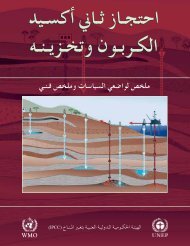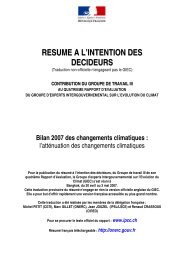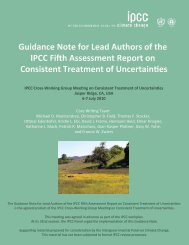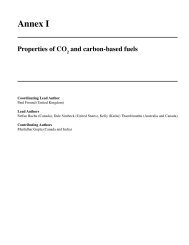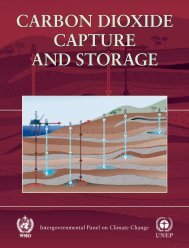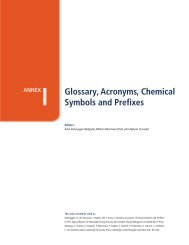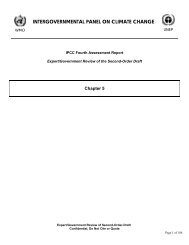SODBatch A&B SPM Comments co-chair response final ... - ipcc-wg3
SODBatch A&B SPM Comments co-chair response final ... - ipcc-wg3
SODBatch A&B SPM Comments co-chair response final ... - ipcc-wg3
You also want an ePaper? Increase the reach of your titles
YUMPU automatically turns print PDFs into web optimized ePapers that Google loves.
Chapter-<br />
Comment<br />
para<br />
Batch<br />
From Page<br />
From Line<br />
To Page<br />
To line<br />
<strong>Comments</strong><br />
IPCC WGIII Fourth Assessment Report, Se<strong>co</strong>nd Order Draft<br />
to to equity <strong>co</strong>nsiderations – it is merely a statement about where<br />
efficient reductions can occur based on existing studies.<br />
It is extremely surprising that for several reasons that the range of<br />
potential mitigation opportunities at given <strong>co</strong>sts is so narrow (8 to<br />
12Gt CO2-eq at US $20 and 18 to 25 Gt at US $100. First, one<br />
would imagine that “e<strong>co</strong>nomic reduction potential” would be very<br />
sensitive to the price of fossil fuels, which are highly uncertain – it<br />
has to matter whether oil is $20 per barrel or $100 per barrel.<br />
Se<strong>co</strong>nd, the state and <strong>co</strong>st of available technology in 2030 is<br />
unknown. Third, the evaluation of “non market <strong>co</strong>sts and (nonclimate)<br />
benefits” that is apparently included in the calculation are<br />
inherently highly speculative, and it is not clear how these <strong>co</strong>sts and<br />
benefits are calculated and whether or not other <strong>co</strong>ntrol measures<br />
are assumed. Fourth, the use of social dis<strong>co</strong>unt rates is<br />
<strong>co</strong>ntroversial and should not be buried in a footnote.<br />
3. There should be an explicit reference, in the text, to the fact that<br />
“e<strong>co</strong>nomic reduction potential” is generally less than “market<br />
reduction potential,” the amount of reduction that might be<br />
achieved under private decision making criteria when a market<br />
value is placed on CO2-eq emissions but other institutional and<br />
decision criteria, such as dis<strong>co</strong>unt rates, are not changed. It is<br />
surprising that for several reasons that the range of potential<br />
mitigation opportunities at given <strong>co</strong>sts is so narrow (8 to 12Gt<br />
CO2-eq at US $20 and 18 to 25 Gt at US $100. First, one would<br />
imagine that “e<strong>co</strong>nomic reduction potential” would be very<br />
sensitive to the price of fossil fuels, which are highly uncertain – it<br />
has to matter whether oil is $20 per barrel or $100 per barrel.<br />
Se<strong>co</strong>nd, the state and <strong>co</strong>st of available technology in 2030 is<br />
unknown. Third, the evaluation of “non market <strong>co</strong>sts and (nonclimate)<br />
benefits” that is apparently included in the calculation are<br />
inherently highly speculative, and it is not clear how these <strong>co</strong>sts and<br />
benefits are calculated and whether or not other <strong>co</strong>ntrol measures<br />
are assumed. Fourth, the use of social dis<strong>co</strong>unt rates is<br />
<strong>co</strong>ntroversial and should not be buried in a footnote.<br />
Expert Review of Se<strong>co</strong>nd-Order-Draft<br />
Confidential, Do Not Cite or Quote<br />
Response suggested by <strong>co</strong><strong>chair</strong>s<br />
is troubling; are we really sure<br />
this is the right definition? (see<br />
also A-658)<br />
Point about mentioning large<br />
potential outside OECD to be<br />
<strong>co</strong>nsidered<br />
Potential will be shown in<br />
table2 or figure (with more<br />
references to the explanation of<br />
the calculation), and is also<br />
mentioned in sectoral<br />
paragraphs.<br />
Be clear that it is not suggested<br />
to be a political issue<br />
Action<br />
for<br />
chapter<br />
Considerations<br />
by the writing<br />
team<br />
<strong>co</strong>untries are<br />
low, how can<br />
the potential be<br />
high?<br />
On Non-market<br />
benefits:<br />
Included in the<br />
benefits is the<br />
saved <strong>co</strong>st on<br />
energy, the<br />
other financial<br />
non-climate<br />
benefits are<br />
non-significant.<br />
Page 177 of 348



